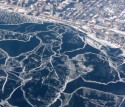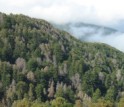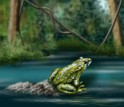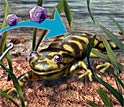News Release 07-093
Ecosystem Stability and Resilience Highlighted at National Conference
NSF-supported research to be presented at Ecological Society of America annual meeting, Aug. 5-10 in San Jose, Calif.
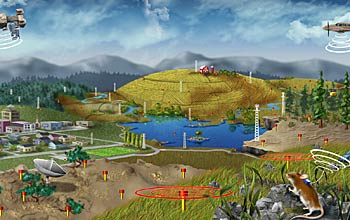
The National Ecological Observatory Network (NEON) is among the topics at the ESA conference.
August 3, 2007
This material is available primarily for archival purposes. Telephone numbers or other contact information may be out of date; please see current contact information at media contacts.
The National Science Foundation (NSF) funds research on the theoretical and conceptual basis of the science of ecology, including the role of stability and diversity in ecosystems.
Biologists supported by NSF conduct research in many related areas: from development of national observing systems to understand regional- and continental-scale ecological changes; to climate change and its effects on biodiversity; to the ecology of infectious diseases; to the spread of invasive species.
Scientists will present results of this research at the annual Ecological Society of America (ESA) meeting in San Jose, Calif., August 5-10, 2007.
NSF-supported research results that will be presnted at the meeting are highlighted below, by day.
MONDAY, AUGUST 6, 2007
The National Ecological Observatory Network (NEON): Infrastructure to advance ecological theory and the interconnectedness of life
The overall goal of NEON--a regional- to continental-scale network of instruments--is to provide information about the interactions among the biosphere, geosphere and atmosphere.
In addition to developing a better understanding of ecological theory, NEON scientists will pursue such questions as: how will ecosystems and their components respond to changes across a range of space and time scales? What is the pace and pattern of those responses? How do biogeochemistry, biodiversity, hydroecology and biotic structure and function interact with these changes?
NEON will support research and education on these and other major environmental challenges.
At a session on the National Ecological Observatory Network, NSF Assistant Director for Biological Sciences James Collins; NEON CEO David Schimel; and others are scheduled to address how NEON will help with answering these questions. Attendees will receive an introduction to and overview of the NEON project.
SS3: Monday, August 6, 2007, 10:00 a.m. - 11:30 a.m., A 2&7, San Jose McEnery Convention Center
[ There will also be a graduate student and post-doc "bagels with NEON leadership" meeting the following morning. Tuesday, August 7, 2007, 7:00 - 8:00 a.m., Blrm Salon IV, San Jose Marriott ]
Opportunities for NSF funding in environmental biology
Program directors from NSF's Division of Environmental Biology will discuss opportunities for support of environmental biology research projects, and provide insights into the peer review system.
SS 4: Monday, August 6, 2007, 10:00 a.m. - 11:30 a.m., A3&6, San Jose McEnery Convention Center
How ecologists can obtain funding from NSF's Education and Human Resources (EHR) Directorate
Program directors from NSF and scientists from the ecological community will provide insights and strategies into seeking funding from NSF's Education and Human Resources (EHR) Directorate.
SS 7: Monday, August 6, 2007, 10:00 a.m. - 11:30 a.m., B3&4, San Jose McEnery Convention Center
Role and accomplishments of national ecology programs like NEON, LTER and REU in diversifying the workforce
Ecologists recognize the importance of bringing the full diversity of the U.S. population into the community of scientists that identifies and frames environmental problems, and into the partners and citizens who will solve these problems, according to Alan Berkowitz of the Institute of Ecosystem Studies in Millbrook, N.Y. Such efforts to increase diversity are goals of NSF's National Ecological Observatory Network (NEON) effort, Long-Term Ecological Research (LTER) program, and Research Experiences for Undergraduates (REU) program. Berkowitz will talk about how these programs have helped to diversify the scientific workforce.
SS 10: Monday, August 6, 2007, 8:00 p.m. - 10:00 p.m., A4&5, San Jose McEnery Convention Center
TUESDAY, AUGUST 7, 2007
Climate change: Animal and plant population responses
How populations of plants and animals will respond to global warming is a major concern as Earth heats up. New research results on phenology--the study of the influence of climate on annual events like budding of lilac trees and timing of ice-out in lakes--will be presented in a session on climate change and population responses.
Ice freeze and break-up dates in lakes across the Northern Hemisphere, for example, show consistent and widespread changes. Over a 150-year period, 1855-2005, freeze dates in lakes in winter have become 8.4 days/century later, and break-up dates in spring 8.5 days/century earlier, according to Barbara Benson, Olaf Jensen and John Magnuson of the University of Wisconsin at Madison. Rates of change have been greatest in the last 30 years. The scientists have studied these long-term trends at NSF's North Temperate Lakes Long-Term Ecological Research (LTER) site in Wisconsin, one of 26 such NSF LTER sites, and across the Northern Hemisphere. Their research results will be presented in this session.
Other subjects include the influence of climate on Kansas prairie plant species (Peter Adler, Utah State University), and changes in dates of emergence from hibernation by chipmunks, ground squirrels and marmots at high-altitudes in Colorado's Rocky Mountains (David Inouye, University of Maryland).
COS 41: Tuesday, August 7, 2007, 1:30 p.m. - 5:00 p.m., J3, San Jose McEnery Convention Center
Outbreak: Sudden oak death, Lyme disease and other diseases on the march
Phytopthora ramorum, is its name. Better known as the pathogen that causes sudden oak death and has resulted in die-offs of countless oak trees on the West Coast, it's on the march and is affecting other trees and shrubs, from bay laurel to redwoods to tanoaks, according to Dave Rizzo of the University of California at Davis. In this ESA session, Rizzo and colleagues will present research results on the spread of this pathogen.
Other topics to be covered include landscape rodent dispersal as a triggering mechanism for rodent-borne disease outbreaks, by Robert Parmenter of the Valles Caldera Trust in New Mexico and Terry Yates of the University of New Mexico, and impacts of an emerging forest pathogen on tick abundance and Lyme disease in California (Andrea Swei of the University of California at Berkeley, Cheryl Briggs of the University of California at Santa Barbara and others).
PS 25: Tuesday, August 7, 2007, 5:00 - 6:30 p.m., Exhibit Halls 1 and 2, San Jose McEnery Convention Center
Dynamics and diversity of animal and plant communities
Many numerical tools exist for describing plant and animal community structure and how that structure changes over time, according to biologist Scott Collins of the University of New Mexico. Using data from three of NSF's 26 Long-Term Ecological Research (LTER) sites--Sevilleta in New Mexico, Konza Prairie in Kansas, and Cedar Creek in Minnesota--Collins used rank clocks, in which the rank order abundance of each species is plotted at each sample date in a clockwise direction, to display and quantify changes in species abundances.
A rank clock is a way of visualizing changes over time in a ranked order of any set of objects, where the ordering is from large to small. The sizes of cities, of firms, the distribution of incomes, and other social and economic measures, all display "rank clock" distributions.
Rank clocks and rank abundance statistics provide important insights into plant and animal community dynamics, insights that are hidden in traditional statistical approaches, say Collins and colleagues. At Cedar Creek, for example, fertilized plots showed high initial species shifts that rapidly decreased to rates below those of unfertilized plots. And species shifts were higher in unburned vs. annually burned grassland at Konza Prairie, and throughout time in grassland compared to shrubland at Sevilleta.
COS 42: Tuesday, August 7, 2007, 1:30 p.m. - 5:00 p.m., J4, San Jose McEnery Convention Center
WEDNESDAY, AUGUST 8, 2007
Invasions, extinctions and climate change: The case of desert rodents
How will ecosystems change as a result of global warming? To find out, ecologists are stepping back in time to look at historical records. Morgan Ernest of Utah State University and colleagues have studied how desert rodents are responding to changes in their environment. The desert rodent community near Portal, Arizona, has responded to several shorter-term extreme climatic events, and habitat change driven by long-term climate change, as well as the invasion of a novel species and the extinction of a dominant species. Ernest will discuss the impact on and response of this community of animals to invasions, extinctions and climate change.
OOS 22: Wednesday, August 8, 2007, 8:00 a.m. - 11:30 a.m., B1&2, San Jose McEnery Convention Center
Partnerships between scientists and artists enhance ecological research, art and ecological restoration
Although the disciplines of science and art are often placed on opposite ends of the continuum of "ways of knowing," the two approaches share many goals and activities: observing and recording nature; moving an audience to gain a deeper awareness, understanding of and appreciation for nature; and sharpening technical skills. In this session, Nalini Nadkarni of Evergreen State College and Fred Swanson of the H.J. Andrews Long-Term Ecological Research (LTER) site in Oregon will bring together poets, artists, dancers and others to talk about how ecologists can harness another way of knowing to enhance restoration and conservation efforts.
OOS 21: Wednesday, August 8, 2007, 8:00 a.m. - 11:30 a.m., A4&5, San Jose McEnery Convention Center
THURSDAY, AUGUST 9, 2007
Virus transmission in tiger salamanders: can it lead to extinction? Research proves otherwise.
Disease theory states that pathogens are unable to drive a host population to extinction, if transmission of the pathogen to susceptible hosts is density-dependent (such as happens in influenza) rather than frequency-dependent (as in HIV-AIDS).
Amy Greer and James Collins of Arizona State University (Collins is on leave from ASU while serving at NSF) used a model to test the assumption that transmission of the Ambystoma tigrinum virus (ATV) is density-dependent in the tiger salamander, Ambystoma tigrinum. ATV is a lethal virus originally found in salamanders in the San Rafael Valley in southern Arizona by ASU researchers.
Greer's and Collins' results show that ATV is indeed a virus with density-dependent transmission, and that although viral infection causes declines in these salamanders, it is not driving them to extinction.
COS 113: Thursday, August 9, 2007: 8:00 a.m. - 11:30 a.m., F1, San Jose McEnery Convention Center
Commercial trade of plants and wildlife in a changing world: research to inform policy
Humans are responsible for transporting plants, animals and their associated pathogens worldwide, through global commerce. Each year, 250 million live animals and 300 million garden and house plants are imported into the U.S. This transport is now widely cited as a major threat to biodiversity. Scientists are trying to understand the extent of this trade, and its cascading ecological consequences.
In a session on the commercial trade of plants and animals, researchers will discuss the commercial movement of amphibian pathogens in the bait trade; the role of the aquarium trade in species introductions; and the role of international trade in wildlife in the spread of infectious diseases.
Presenters include Christina Romagosa of Auburn University, Angela Picco of Arizona State University, Peter Daszak of the Consortium for Conservation Medicine, Dianna Padilla of Stony Brook University and David Lodge of the University of Notre Dame.
OOS 41: Thursday, August 9, 2007, 1:30 p.m. - 5:00 p.m., Blrm Salon IV, San Jose Marriott
How does climate change relate to disease ecology, and to restoration efforts?
Amphibians, coral reefs, prairie dogs affected
Climate change has been implicated in the recent emergence of several infectious diseases, and climate often influences parasite abundance. What do these conclusions mean for restoration ecology? For ecological restoration to succeed, say Chris Ray and Sharon Collinge of the University of Colorado, co-organizers of a session on climate change and disease ecology, effects of disease must be factored in.
In a talk on the possible role of climate change in triggering disease outbreaks of chytridiomycosis in amphibians, Karen Lips of Southern Illinois University-Carbondale will discuss whether climate change may lead to these disease outbreaks, and what new information is needed to determine whether climate is a culprit. Alternatively, chytridiomycosis may be an emerging pathogen spreading along wavelike fronts through amphibian populations, unrelated to climate change.
Other subjects include endemic cholera in Bangladesh and epidemic malaria in transition regions (Mercedes Pascual of the University of Michigan), and ocean temperature anomalies and coral disease outbreaks (John Bruno of the University of North Carolina at Chapel Hill).
OOS 37: Thursday, August 9, 2007, 8:00 a.m. - 11:30 a.m., A4&5, San Jose McEnery Convention Center
Globalization and the spread of pathogens
The introduction of pathogens to new areas is a key factor in the global emergence of disease, and can result in widespread impacts on communities and ecosystems. Marm Kilpatrick of the Consortium for Conservation Medicine in New York and colleagues will discuss how globalization, a form of human-caused environmental change, is contributing to the spread of pathogens. Globalization, they found, is responsible for the spread of H5N1 avian influenza to countries in Asia, Europe and Africa. The scientists stress the potential synergism between trade and wild animal movements in the emergence and spread of pathogens.
COS 103: Thursday, August 9, 2007: 8:00 a.m. - 11:30 a.m., J1, San Jose McEnery Convention Center
Ecology education: research for undergraduates in theoretical ecology
Research for Undergraduates in Theoretical Ecology (RUTE) is an NSF-funded program at the University of Nebraska-Lincoln. In the program, teams of undergraduates engage in year-long research involving laboratory and field work, as well as mathematical analysis and modeling. The first such project involved the ecology of a painted turtle population in western Nebraska. In a companion summer program, a course in theoretical ecology, taught by biologists and mathematicians, centers on the theme of insect pest control. Students conduct laboratory studies of aphid life history and predation of aphids by lady beetle larvae, and develop mathematical models for the population dynamics of aphids both with and without lady beetles. The successes of the RUTE program will be reviewed by Glenn Ledder and Brigitte Tenhumberg of the University of Nebraska-Lincoln.
PS 58-59: Thursday, August 9, 2007, 5:00 p.m. - 6:30 p.m., Exhibit Halls 1 and 2, San Jose McEnery Convention Center
FRIDAY, AUGUST 10, 2007
An expanding niche? The invasion dynamics of cane toads in Australia
Cane toads have accelerated their range expansion into northern Australia, into areas previously thought to be uninhabitable, according to Mark Urban of NSF's National Center for Ecological Analysis and Synthesis in Santa Barbara, Calif., and colleagues. In their ESA presentation, they will provide new information on this accelerating invasion, which likely has resulted from adaptations for faster dispersal and from environmental conditions that have facilitated the toads' advance. A lack of native enemies and rapid evolution in new habitats provides insights into how some species become highly successful global invaders.
COS 151: Friday, August 10, 2007, 8:00 a.m. - 11:30 a.m., Blrm Salon I, San Jose Marriott
Information technology tools and programs link scientific research to conservation management and restoration: Answers from those "out standing in the field"
"Out standing in the field" refers to the most innovative and bold programs linking scientific research and conservation management. Building on last year's ESA workshop on "How you can REALLY achieve conservation goals: merging academic research with management and restoration," this session will focus on information management tools that enable the transmission of scientific research to conservation and restoration managers.
New developments in cyberinfrastructure are allowing managers to find relevant scientific research and management plans to help them make more effective conservation and restoration decisions.
Topics in this session, moderated by Mikaila Milton of NSF, include creating cyberinfrastructure to involve volunteer groups in citizen science; a research and information database for restoration professionals in the Wild Fish Habitat Initiative; and synthesizing data into a single body of evidence on issues of greatest concern to conservation managers.
OOS 46: Friday, August 10, 2007, 8:00 a.m. - 11:30 a.m., A4&5, San Jose McEnery Convention Center
-NSF-
-
Ice-out dates are earlier in spring, and ice-in dates later in fall, on lakes across the U.S.
Credit and Larger Version -
Sudden oak death has claimed the lives of countless oak trees.
Credit and Larger Version -
Scientists are studying how infectious diseases affect populations of animals and plants.
Credit and Larger Version -
Biologists have discovered that amphibian disease is spread by bait shops.
Credit and Larger Version
Media Contacts
Cheryl Dybas, NSF, (703) 292-7734, email: cdybas@nsf.gov
Related Websites
Ecological Society of America, San Jose Conference: http://www.esa.org/sanjose/
NSF Biological Sciences Directorate: http://www.nsf.gov/bio/
NSF Long-Term Ecological Research Network: http://www.lternet.edu
NSF Special Report: Ecology of Infectious Diseases: http://www.nsf.gov/news/special_reports/ecoinf/index.jsp
NSF Geosciences Directorate: http://www.nsf.gov/dir/index.jsp?org=GEO
The U.S. National Science Foundation propels the nation forward by advancing fundamental research in all fields of science and engineering. NSF supports research and people by providing facilities, instruments and funding to support their ingenuity and sustain the U.S. as a global leader in research and innovation. With a fiscal year 2023 budget of $9.5 billion, NSF funds reach all 50 states through grants to nearly 2,000 colleges, universities and institutions. Each year, NSF receives more than 40,000 competitive proposals and makes about 11,000 new awards. Those awards include support for cooperative research with industry, Arctic and Antarctic research and operations, and U.S. participation in international scientific efforts.
Connect with us online
NSF website: nsf.gov
NSF News: nsf.gov/news
For News Media: nsf.gov/news/newsroom
Statistics: nsf.gov/statistics/
Awards database: nsf.gov/awardsearch/
Follow us on social
Twitter: twitter.com/NSF
Facebook: facebook.com/US.NSF
Instagram: instagram.com/nsfgov



